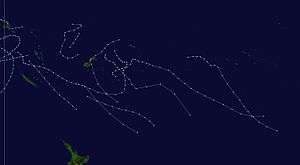1969–70 South Pacific cyclone season
The 1969–70 South Pacific cyclone season was a very inactive season, featuring only seven disturbances, five tropical cyclones, and two severe tropical cyclones. The season featured only one landfalling storm, Cyclone Dawn. Dawn formed very late, on February 10, and the last storm, Tropical Depression Isa, dissipated early, on April 19.
| 1969–70 South Pacific cyclone season | |
|---|---|
 Season summary map | |
| Seasonal boundaries | |
| First system formed | February 10, 1970 |
| Last system dissipated | April 19, 1970 |
| Strongest storm | |
| Name | Dolly & Emma |
| • Maximum winds | 130 km/h (80 mph) (10-minute sustained) |
| • Lowest pressure | 965 hPa (mbar) |
| Seasonal statistics | |
| Total disturbances | 7 |
| Tropical cyclones | 5 |
| Severe tropical cyclones | 2 |
| Total fatalities | 6 |
| Total damage | $5 million (1970 USD) |
| Related articles | |
| |
Seasonal summary

Systems
Tropical Cyclone Dawn
| Category 2 tropical cyclone (Australian scale) | |
| Tropical storm (SSHWS) | |
 | |
| Duration | February 16 – February 19 |
|---|---|
| Peak intensity | 100 km/h (65 mph) (10-min) 980 hPa (mbar) |
Severe Tropical Cyclone Dolly
| Category 3 severe tropical cyclone (Australian scale) | |
| Category 1 tropical cyclone (SSHWS) | |
 | |
| Duration | February 11 – February 25 |
|---|---|
| Peak intensity | 130 km/h (80 mph) (10-min) 965 hPa (mbar) |
Severe Tropical Cyclone Emma
| Category 3 severe tropical cyclone (Australian scale) | |
| Category 1 tropical cyclone (SSHWS) | |
 | |
| Duration | February 27 – March 6 |
|---|---|
| Peak intensity | 130 km/h (80 mph) (10-min) 965 hPa (mbar) |
Tropical Cyclone Gillian
| Category 1 tropical cyclone (Australian scale) | |
| Tropical storm (SSHWS) | |
 | |
| Duration | April 7 – April 11 |
|---|---|
| Peak intensity | 85 km/h (55 mph) (10-min) 980 hPa (mbar) |
Tropical Cyclone Helen
| Category 1 tropical cyclone (Australian scale) | |
| Tropical storm (SSHWS) | |
 | |
| Duration | April 13 – April 17 |
|---|---|
| Peak intensity | 75 km/h (45 mph) (10-min) 990 hPa (mbar) |
On April 17, 1970, Apollo 13 was making its final descent over the splashdown zone when they spotted Cyclone Helen as they were re-entering the earth's atmosphere. Mission control had been tracking the storm to make sure it did not interfere with the mission's re-entry.
Tropical Cyclone Isa
| Category 1 tropical cyclone (Australian scale) | |
| Tropical depression (SSHWS) | |
 | |
| Duration | April 14 – April 19 |
|---|---|
| Peak intensity | 75 km/h (45 mph) (10-min) 990 hPa (mbar) |
Other systems
During January 5, the Australian Bureau of Meteorology first noted the existence of a weak tropical depression over the eastern Coral Sea, however, it has since been determined that the depression developed during January 2 near 15.8°S 165.1°E.[1][2] The system was subsequently tracked by infrequent satelitte imagery, which revealed that it slowly completed a cyclonic loop near the Solomon Islands before curving back toward the southwest.[1] The system entered the Australian region during 15 January, where it subsequently became Severe Tropical Cyclone Ada before making landfall on Queensland during 17 January.[1]
Seasonal effects
| Name | Dates active | Peak classification | Sustained wind speeds |
Pressure | Areas affected | Damage (USD) |
Deaths | Refs |
|---|---|---|---|---|---|---|---|---|
| Priscilla | December 15 – 19 | Category 1 tropical cyclone | 75 km/h (45 mph) | 990 hPa (29.23 inHg) | Fiji | Minor | [3] | |
| Ada | January 2 – 15 | Tropical depression | 55 km/h (35 mph) | 997 hPa (29.44 inHg) | Vanuatu, Solomon Islands | None | None | |
| Dawn | February 10 – 19 | Category 1 tropical cyclone | 65 km/h (40 mph) | 990 hPa (29.23 inHg) | New Caledonia and Northern Queensland | $5 Million | 6 | |
| Dolly | February 11 – 25, 1970 | Category 3 Severe Tropical Cyclone | 130 km/h (80 mph) | 965 hPa (28.50 inHg) | [4] | |||
| Emma | March 2 – 4, 1970 | Category 3 Severe Tropical Cyclone | 130 km/h (80 mph) | 965 hPa (28.50 inHg) | [5] | |||
| Season aggregates | ||||||||
| 7 systems | October 29 – March 23 | |||||||
References
- Gibbs, W. J. (June 1970). "Report by Director of Meteorology on Cyclone 'Ada'" (PDF). Bureau of Meteorology. Retrieved 22 April 2017.
- "The Australian Tropical Cyclone Database" (CSV). Australian Bureau of Meteorology. A guide on how to read the database is available here.
- Waygood, J.L.M. (October 20, 1980). Tropical Cyclones affecting Fiji: November 1969 to April 1980 (Information Sheet No. 59). Fiji Meteorological Service.
- "1970 Tropical Cyclone Dolly (1970043S15163)". International Best Track Archive for Climate Stewardship. Retrieved October 21, 2019.
- "1970 Tropical Cyclone Emma (1970058S15200)". International Best Track Archive for Climate Stewardship. Retrieved October 21, 2019.